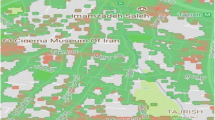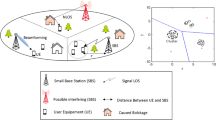Abstract
The increasing growth of wireless applications leads to the congestion of radio spectrum below 10 GHz. This has slowed down the growth of high data rate applications due to the limited bandwidth of currently used frequency bands. This prompted wireless service providers to look for 30–300 GHz frequency band for mobile Broadband and enhanced mobile Broadband services. In this paper, the performance of 5G cellular networks at 30 GHz frequency by suppressing the interference caused by multiple transmissions from potential interferers sharing the same physical medium has been studied. Here initially the appropriate interference model that can predict the outage events in 5G cellular networks in any scenario has been investigated. Next using a cellular network site in dense urban environment with high traffic loads, user density and pedestrian and vehicular movement was created. The signal-to-interference-plus-noise ratio (SINR) is visualized for different antenna systems on a map using real geospatial information. The SINR maps of single antenna element and antenna array are plotted and compared. Both Free-space propagation model and Close-in-Propagation model are used to compare the results. Also using a uniform planar array of antennas on network-side the directionality increases hence interference reduces and higher values of SINR are achieved.



















Similar content being viewed by others
References
Akdeniz, M., Liu, Y., Samimi, M., Sun, S., Rangan, S., Rappaport, T., et al. (2014). _Millimeter wave channel modeling and cellular capacity evaluation,_ IEEE. IEEE Journal on Selected Areas in Communications,32(6), 1164–1179.
Shokri-Ghadikolaei, H., Fischione, C., Fodor, G., Popovski, P., & Zorzi, M. (2015). Millimeter wave cellular networks: A MAC layer perspective. IEEE Transactions on Communications,63(10), 3437–3458.
Di Renzo, M. (2015). _Stochastic geometry modeling and analysis of multi-tiermillimeter wave cellular networks. IEEE Transactions on Wireless Communications,14(9), 5038–5057.
Rappaport, T. S., Heath, R., Daniels, R. C., & Murdock, J. N. (2014) Millimeter Wave Wireless Communications. Pearson Education.
Jiang, X., Shokri-Ghadikolaei, H., Fischione, C., & Pang, Z. (2016) A simplified interference model for outdoor millimeter wave networks. In International wireless internet conference (pp. 101–108). Springer, Cham.
Akdeniz, M. R., & Rangan, S. (2013). Optimal wireless scheduling with interference cancellation. In Proceedings of IEEE international symposim infomation theory, Istanbul, Turkey, July 2013 (pp. 246–50).
Draft new Report ITU-R M.[IMT-2020.EVAL]—Guidelines for evaluation of radio interface technologies for IMT-2020.
Abdrashitov, V., Nam, W., & Bai, D. (2014). Rate and UESelection algorithms for interference-aware receivers. Proc. IEEE VTC 2014-Spring, May 2014, Seoul, Korea.
Nam, W., Bai, D., Lee, J., & Kang, I. (2014). Advanced interference management for 5G cellular networks. IEEE Communications Magazine,52(5), 52–60.
Report ITU-R M.2135-1, “Guidelines for evaluation of radio interface technologies for IMT-Advanced”, 2009. https://www.itu.int/dms_pub/itu-r/opb/rep/R-REP-M.2135-1-2009-PDF-E.pdf.
Le,L. B., Modiano, E., Joo, C., & Shroff, N. B. (2010). Longest-queue-first scheduling under SINR interference model. In Proceedings on ACM international symposium on mobile Ad hoc Networking and Computing (MobiHoc) (pp. 41–50).
Weber, S. P., Andrews, J. G., Yang, X., & De Veciana, G. (2007). Transmission capacity of wireless ad hoc networks with successive interference cancellation. IEEE Transactions on Information Theory,53(8), 2799–2814.
Shokri-Ghadikolaei, H., Fischione, C., & Modiano, E. (2016). Interference models similarity index. KTH Royal Institute of Technology, Tech.Rep., available upon request.
Chiang, M., Hande, P., Lan, T., & Tan, C. W. (2008). Power control in wireless cellular networks. Foundations and Trends® in Networking,2(4), 381–533.
Freeman, R. L. (2015). Telecommunication system engineering (Vol. 82). Hoboken: Wiley.
Sun, S., et al. (2016). Investigation of prediction accuracy, sensitivity, and parameter stability of large-scale propagation path loss models for 5G wireless communications. IEEE Transactions on Vehicular Technology,65(5), 2843–2860.
Sun, S. et al. (2016). Propagation path loss models for 5G urban micro- and macro-cellular scenarios. In Proceedings on IEEE 83rd VTC Spring, Nanjing, China, May 2016. [Online]. Available: http://arxiv.org/abs/1511.07311.
Sun,S., Mac Cartney, Jr. G. R., & Rappaport, T. S. (2016). Millimeter-wave distance-dependent large-scale propagation measurements and path loss models for outdoor and indoor 5G systems. In Proceedings on 10th EuCAP, Davos, Switzerland, Apr. 2016. [Online]. Available: http://arxiv.org/abs/1511.07345.
Rappaport, T. S., MacCartney, G. R., Jr., Samimi, M. K., & Sun, S. (2015). Wide band millimeter-wave propagation measurements and channel models for future wireless communication system design (Invited Paper). IEEE Transactions on Communications,63(9), 3029–3056.
Author information
Authors and Affiliations
Corresponding author
Additional information
Publisher's Note
Springer Nature remains neutral with regard to jurisdictional claims in published maps and institutional affiliations.
Rights and permissions
About this article
Cite this article
Banday, Y., Rather, G.M. & Begh, G.R. SINR Analysis and Interference Management of Macrocell Cellular Networks in Dense Urban Environments. Wireless Pers Commun 111, 1645–1665 (2020). https://doi.org/10.1007/s11277-019-06947-1
Published:
Issue Date:
DOI: https://doi.org/10.1007/s11277-019-06947-1




